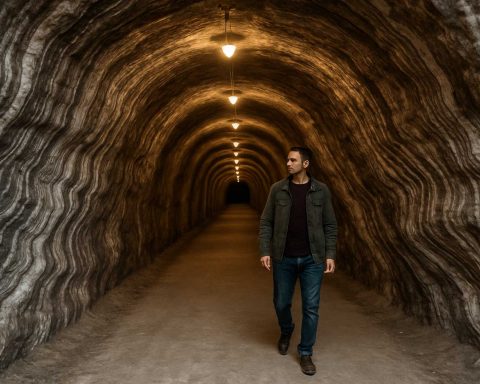- The digital self-custody of bitcoin offers control and freedom from third-party interference but comes with hidden risks.
- Physical storage solutions for bitcoin keys, like metal plates, are vulnerable to natural disasters such as wildfires.
- Natural disasters highlight the Achilles’ heel of cold storage—its vulnerability to destruction despite vault-like protection.
- Innovative solutions like multi-signature approaches distribute keys across locations for added security against both human error and natural disasters.
- Platforms like Coinbase are integrating security with simplicity, offering multi-authentication with user-friendly designs.
- Inheritance solutions are critical to prevent bitcoin from becoming inaccessible after the owner’s death.
- Preparedness is essential in the volatile world of bitcoin self-custody, emphasizing proactive risk management strategies.
In the crackling heat of California wildfires, shimmering waves distort the air, a fitting metaphor for the invisible, incendiary risks shaking the world of bitcoin. As fiery embers drift lazily through the sky, they threaten not just homes and lives, but the future of self-custodied digital wealth.
For those who clutch their cryptocurrency close, eschewing the safety nets of “hot wallets” offered by brokerage firms, the rewards of self-custody can seem supreme—absolute control, freedom from third-party interference, and a nod to the libertarian spirit of the original bitcoin pioneers. But these promises are enmeshed with a maze of hidden risks.
Visualize this: a metal plate, designed to be a fortress of safeguarding with etched seed phrases, reduced to molten fragments amid the ashes of a devastated home. While it might sound improbable, social media whispers in the wake of California’s infernos sketch a picture of bitcoin keys swallowed by the flames—claims of vanished memories, irretrievable wealth.
Bitcoin holders stand at a crossroads. Should they trust the sturdiness of self-custody—cold and hardware wallets safely distant from the internet’s clutches—or lean toward the convenience and structural security promised by platforms like Coinbase? It’s a familiar yet deeply personal choice, ripe with stakes as high as those in any financial market.
Cold storage, with its promise of vault-like protection, reveals an Achilles’ heel: the tangible vulnerability of physical items. Natural disasters make no exceptions for metal or human foresight—there’s no anticipating when a wildfire might devour a backup or when a hurricane might submerge a supposedly indestructible vault.
Emerging as soldiers in this evolving battleground are solutions like Casa’s multi-signature approaches, distributing keys across digital peripheries and geographic divides. This army of five keys, needing only three to unlock treasure troves of bitcoin, forms a defense against both human error and nature’s fury. It’s a dance between redundancy and accessibility, designed to outsmart calamity before it hastens its heavy blow.
In elaborate digital ecosystems, companies like Coinbase and Block are striving to harmonize security with simplicity. Their offerings aim to marry the rigor of multi-authentication measures with user-friendly interfaces, a testament to the ongoing quest to tame this digital beast.
Yet, these security solutions—whether fireproof bags or indestructible plates—are worth little if overshadowed by humanity’s greatest certainty: mortality. The thoughtful inheritance solutions now emerging are as important as they are timely, aiming to prevent an untold wealth from slipping into the shadowy ether due to owners’ untimely departures.
When wildfires scorch the Californian landscape or conflicts unsettle the Middle East, the crypto community feels the tremors. As these tectonic shifts rattle the bedrock of digital sovereignty, the message is clear: forge peace not just with technology’s advances, but with prudent, preemptive action. Reassess your strategies before the flames of misfortune draw near.
For those journeying down the path of bitcoin self-custody, the digital realm remains a wild frontier, both alluring and precarious. Navigating it requires a blend of technological savvy and an inherent understanding that inaction can lead to the evaporation of assets far more quickly than it took to gather them. In this landscape, preparedness isn’t just a choice. It’s a mandate.
Protecting Your Bitcoin: How to Fortify Your Assets Against Natural Disasters
As wildfires rage through California, they serve as a stark reminder of the vulnerabilities faced by those who keep their bitcoin in self-custody. The allure of complete control and independence in self-custody comes with the significant risk of physical damage to the storage devices and materials that hold cryptocurrency keys. This article delves deeper into self-custody, offering insights into how bitcoin holders can safeguard their digital assets against catastrophe.
The Intricacies of Self-Custody
Bitcoin holders who choose self-custody must be aware of the physical threats to their storage solutions. While cold storage devices like hardware wallets are secure from online threats, they are still susceptible to natural disasters like fires, floods, and more.
Key Facts:
– Types of Wallets:
– Cold Wallets: Hardware wallets such as Trezor and Ledger are disconnected from the internet, enhancing protection against digital theft. However, they can be physically lost or destroyed.
– Hot Wallets: Connected to the internet, making them easier targets for hackers. These do include platforms like Coinbase link name which offer safety features but hold keys on behalf of the user.
– Natural Hazards:
– Physical destruction from fires, floods, and other disasters can render storage devices or etched seed phrases unusable, effectively losing access to your funds.
Minimizing Risks with Multi-Signature Wallets
Multi-signature wallets, like those offered by Casa, require multiple keys to authorize bitcoin transactions. This approach helps to distribute risk and adds a layer of redundancy.
How-To Steps to Implement:
1. Research Platforms: Choose a reputable platform that offers multi-signature features.
2. Distribute Keys: Store keys in different physical locations to protect against single-point failures.
3. Use a Mix of Storage Methods: Combine hardware wallets with secure online platforms for one or more of the required keys.
Market Trends and Innovations
As the crypto market evolves, innovations are seen in the way digital assets can be stored and protected:
– Fireproof Materials: Companies are creating fireproof bags and boxes designed to withstand extreme temperatures, protecting physical storage devices.
– Indestructible Backup Plates: These are made from materials like titanium, intended to survive fires and other disasters, where recovery phrases can be engraved.
Real-World Use Cases and Practical Tips
In real-world scenarios, individuals have successfully retrieved their crypto investments by:
– Keeping Backups Off-Site: Ensuring at least one backup is stored in a different location, ideally in a bank vault or with a trusted third party.
– Testing Recovery Plans: Regularly testing the ability to restore wallets using recovery phrases.
Challenges and Controversies
Self-custody is not without its challenges and controversies:
– Loss of Assets: There have been reports of significant crypto losses due to lost or inaccessible keys.
– Inheritance Issues: Without a clear plan, bitcoin can be lost forever if the holder cannot pass on keys or recovery phrases to heirs.
Security, Sustainability, and Future Outlook
Going forward, balancing security and sustainability will be key in crypto storage:
– Green Solutions: There’s a push for more environmentally sustainable practices in bitcoin mining and storage.
– Technologic Integration: The trend is moving towards better integration of security with user-friendly solutions.
Actionable Recommendations
1. Diversify Storage: Use both online and offline methods for storing your keys.
2. Fireproof and Floodproof Solutions: Invest in specialized storage products to protect against natural disasters.
3. Plan for the Future: Create a detailed plan for inheritance, ensuring access to your assets if something happens to you.
4. Stay Informed: Regularly update your knowledge of new storage solutions and security measures.
For more insights and resources, visit trusted crypto platforms like Blockchain.
By taking preemptive measures and considering all possible scenarios, you can safeguard your digital wealth from the unpredictability of natural events. Use this guide to enhance your crypto asset protection strategy today.







